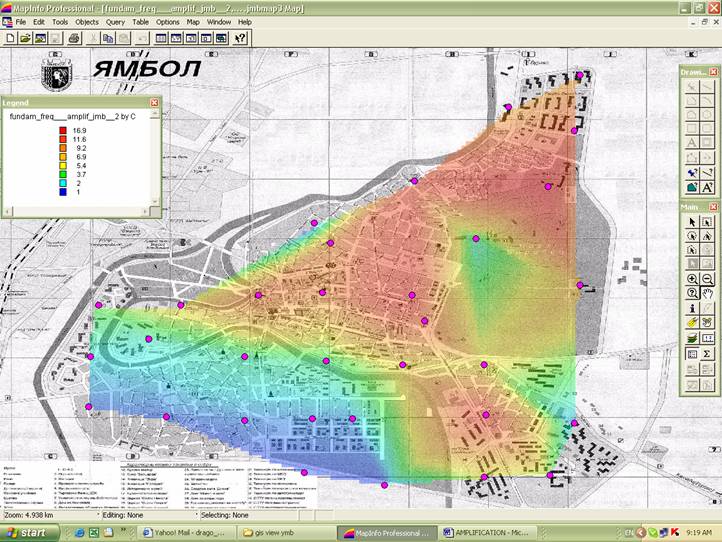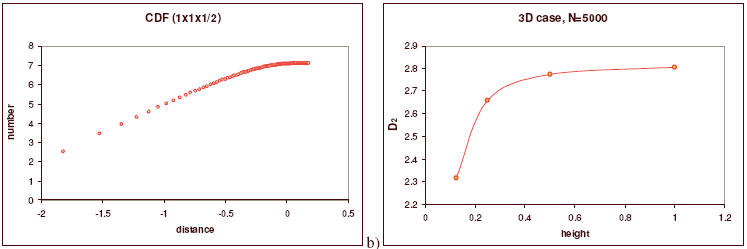|
RETAS
model -
Restricted
Epidemic
Type
Aftershock
Sequence
model.

The stochastic model was developed by
Gospodinov
and Rotondi (2006) and it is based on the idea that only aftersocks
stronger than some magnitude threshold Mth can trigger secondary
aftershock activity (on the figure above this threshold is 4.5). Thus, by changing the threshold Mth
from the magnitude cut-off Mo to the main shock magnitude
Mmain, RETAS chooses the best fit stochastic model for the
temporal behavior of the sequences among a number of models including the
MOF and the ETAS models as limit cases.
Site
effect assessment using H/V spectral ratio technique
-

the
H/V spectral ratio method is an experimental technique to evaluate some
characteristics of soft-sedimentary (soil) deposits. Due to its low-cost
both for the survey and analysis, the H/V technique has been frequently
adopted in seismic microzonation investigations.
The method has proven to be
useful to estimate the fundamental period of soil deposits. However,
measurements and the analysis should be performed with caution. The main
recommended application of the H/V technique in microzonation studies is
to map the fundamental period of the site and help constrain the
geological and geotechnical models used for numerical computations (a
map of the fumdamental frequency for the town of Jambol - SE Bulgaria).
This technique is most effective in estimating the natural
frequency of soft soil sites when there is a large impedance contrast
with the underlying bedrock. The method is especially recommended in
areas of low and moderate seismicity, due to the lack of significant
earthquake recordings, as compared to high seismicity areas.
The
technique was applied to seisic noise records from the towns of Plovdiv
(Kandilarov,
Atakan,
Havskov and Gospodinov, 2009) and Jambol in Bulgaria and from Bergen, Norway. The results are being
prepared for publication.
Fractal Properties
analysis

The
application of fractal distribution analysis has
some specific aspects. It is usually difficult to present an
adequate interpretation of the obtained values of fractal
coefficients for earthquake epicenter or hypocenter distributions. That
is why we aim at other goals – to verify how a
fractal coefficient depends on different spatial distributions (Gospodinov,
Marekova, Marinov, 2009).
We
simulate earthquake spatial data by generating randomly points
first in a 3D space - cube, then in a parallelepiped, diminishing
one of its sides. We then continue this procedure in 2D and 1D
space. For each simulated data set we calculate the points’
fractal coefficient (correlation fractal dimension of epicenters)
and then check for correlation between the coefficients values
and the type of spatial distribution.
In that way one can obtain a set of standard fractal coefficients’
values for varying spatial distributions. These then can be
used when real earthquake data is analyzed by comparing the real
data coefficients values to the standard fractal coefficients.
Such an approach can help in interpreting the fractal analysis
results through different types of spatial distributions.
|
Recent projects
2009 -
2010,
ŠŃ09-ŌŌ-011/15.04.2009, Plovdiv University "Paisiy Hilendarski", "Study
of seismic hazard features by stochastic modeling and ambient noise
analysis" (coordinator
- Dragomir Gospodinov)
2006
- 2008, Project BG-9/2005 (bilateral BG-Greece (“Aristotle University”)
- Bulgaria (GFI) cooperation) on “Seismogenesis and interactions
between earthquake sources in the Southern Balkans” (continuation;
coordinator - Dragomir Gospodinov)
2006
- 2007, Risk analysis by MAHB and NEDIES - action 4332 of EC-DG-JRC
(coodinator - Boyko Ranguelov)
2006
- Project with TIG-DVO, RAN-Russia “Seismotectonics and properties of the
strong earthquake sources”,
(coodinator - Boyko Ranguelov)
2005
- Site effect assessment using H/V spectral ratio and Standard Spectral Ratio
methods in the 'Old Town' area of Plovdiv city - Bulgaria, project with the
Institute of Solid Earth Physics - University of Bergen, Norway (coodinator -
Dragomir Gospodinov)
Research
partners we keep active cooperation with:
-
Prof. Eleftheria Papadimitriou and Prof.
Vassilios Karakostas - Department of
Geophysics, School of Geology at the "Ariatotle' University in
Thessaloniki, Greece
- Dr. Renata
Rotondi - Consiglio Nazionale delle Ricerche Istituto di Matematica
Applicata e Tecnologie Informatiche (IMATI),
(Milano Department), Italy -
Alexander Kandilarov and Prof. K. Atakan - Bergen University, Norway -
Associate Professor Boyko Ranguelov - National
Instituteof Geophysics, Geodesy and Geography -
Dr. Galina Lyamikina - Tihookeanskij institut geofiziki (TIG-DVO),
RAN-Russia |
Recent publications
Gospodinov,
D. and Rotondi, R., (2001), Exploratory analysis of marked
Poisson Processes
applied to Balkan
earthquake
sequences,
Journ. Balkan Geoph. Soc., 4, 3, 61-68.
Gospodinov,
D., V. Karakostas, R. Papadimitriou, (2005), Stochastic modelling of the
relaxation process after the M=9.0 Sumatra
earthquake of December 26, 2004; preliminary analysis, Proc. of the 4th
Con. of the Balkan Geoph. Society, 9-12 October 2005, Bucharest, Romania,
pp.327-330
Gospodinov,
D., B. Ranguelov, E. Papadimitriou, V. Karakostas, (2005),
Statistical methods to analyze seismicity
interaction in neighbor zones; application to simulated data, Proc. of the
80-years Anniv.Intern. Sci.Conference on Geology, Sofia, November 17-18, 2005,
pp.185-188
Gospodinov
D. and Rotondi R., (2006), "RETAS: a restricted ETAS model inspired,
by Bath's law", The 4th Internat.Workshop on Statistical Seismology,
The Graduate University for Advanced Studies, Shonan Village, Japan,
9-13 January 2006, ISM (Institute of Statistical Mathematics) Report on Research
and Eucation No. 23, 92-95.
Gospodinov,
D., R. Rotondi,(2006), Statistical
Analysis of Triggered Seismicity in the Kresna Region of SW Bulgaria (1904) and
the Umbria-Marche Region of Central Italy (1997), Pure
appl. geophys., 163, 1597–1615
Tranos
M., Karakostas V., Papadimitriou E., Kachev V., Ranguelov B., Gospodinov D.,
(2006), Major active faults of SW Bulgaria: implications of their geometry,
kinematics and the regional active stress regime., in Tectonic development
of the Eastern Mediterranean region. (Robertson A. and Mountrakis D. - eds.),
Geological Society of London, Special publications 260, pp. 671-687.
Karaksotas
V., Papadimitriou E., Gospodinov D., Ranguelov B., (2006),
Slip
distribution for the 1928 Chirpan and Plovdiv
main shocks and earthquake triggering., Proc. Intl.Conf. SGEM 2006 - papers.,
Albena, 12-16 June., vol. 2, p.119-126.
B.
Ranguelov, S. Dimitrova, D. Gospodinov, G. Lamykina, (2007). Geodynamics of the
South Balkans - Seismotectonic Model, Fractality and Nonlinear
Properties., in Monograph GEODYNAMICS OF THE BALKAN PENINSULA (Ed.G.Milev),
Reports of Geodesy, No. 5 (80), pp. 609 – 626.
Papadimitriou
E., V. Karakostas, M. Tranos, B. Ranguelov, D. Gospodinov., (2007). Static
stress changes associated with normal
faulting earthquakes in South Balkan area., Int. J. Earth Sci. (Geol. Rundsch.),
Springer-Verlag, Volume 96, Number 5, pp. 911-924, DOI:
10.1007/s00531-006-0139-x
Gospodinov
D., Ranguelov B., Papadimitriou E. and Karakostas V., (2007), Exploratory
Application of a Compound Poisson Process to Model Aftershock Energy Release after
the Denali Fault M7.9 earthquake, November 3, 2002., Proc. 17th
Intl. Symp. Geodesy’07,
Sofia
, 8-9.Nov. šp. 303-313.
Gospodinov
D., Ranguelov B., Karakosttas V., Papadimitriou E., Tanev A., Kandilarov A.,
(2007). Preliminary results on the implementration of the H/V spectral ratio
technique on ambient vibrations in the town of
Jambol.
, Ext. abstr. Nat.Conf. Geosciences’07.,
December 13-14, 2007
,
Sofia
, 127-128 pp.
Marekova
E.,
Ranguelov
B.
and
Gospodinov
D.,
(2007). Statistical Investigations
of earthquake
sequences on
different regions
of the
world., accepted
for public.
In Proc.
Nat.Conf.
Geosciences’07.,
December 13-14, 2007
,
Sofia
Gospodinov
D., Karakostas, Papadimitriou E., Ranguelov B., (2007),
Analysis
of relaxation temporal patterns in
Greece
through the RETAS model approach.,
Physics
of the Earth and Planetary Interiors (PEPI), Vol 165/3-4, pp 158-175, DOI
information: 10.1016/j.pepi.2007.09.001
Kandilarov A., Atakan K., Havskov J., Gospodinov
D. (2009) An investigation of the
significance of local site effects in
Plovdiv, Bulgaria, Bulletin of Earthquake Engineering. 7, 181-198,
DOI 10.1007/s10518-008-9091
Ranguelov B., G. Alexiev,
D.Gospodinov., (2009), Natural Hazards Cartography in Bulgaria – a European
perspective. Proc. 19th Intl. Symp. Geodesy 09., Sofia, 5-6 Nov.
2009, pp. 260-266. ISBN: 978-80-87159-07
Gospodinov D., E. Marekova , A.
Marinov, (2009), Verifying the Dependence of Fractal
Coefficients on Different Spatial Distributions,
AIP, 2010,
AIP Conference Proceedings, 1, 731-736,
DOI: 10.1063/1.3322545,
http://link.aip.org/link/?APC/1203/731/1
Gospodinov D., Papadimitriou E. and Karakostas
V., Ranguelov B, (2009), Energy release patterns in aftershock sequences of
North Aegean Sea (Greece) through stochastic modelling, Cashiers du Centre
Europeen de Geodynamique et de Seimologie, Vol.28. p. 141-146
Astiopoulos, A.C., Papadimitriou, E.,
Karakostas, V., Gospodinov, D., Drakatos, G., (2010), Seismicity changes
detection during the seismic sequences evolution as evidence of stress changes,
Proc.
12th International Congress of the Geological Society of Greece, May 19-20,
2010, Thessaloniki, Greece, p. 1994-2004
top
Webmaster:
drago@uni-plovdiv.bg






